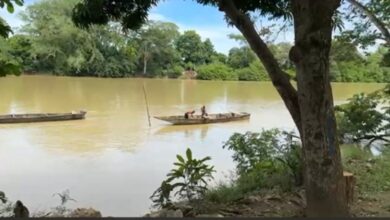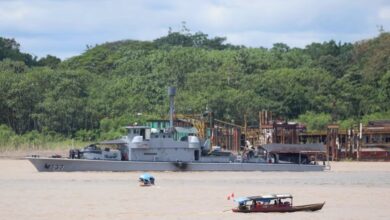Rivers: the open veins of the planet
Rivers are currents of surface water, which flow through the force of gravity through a bed .

Rivers fulfill the function of irrigation of the planet, so their care is key to guaranteeing human life in the long term. / Photo: Unsplash
LatinAmerican Post | Jorgue Guasp
Listen to this article
Leer en español: Ríos: las venas abiertas del planeta
Famous rivers of the world
Could we talk about Paris without mentioning the River Seine? The Thames is an indissoluble part of London. Before flowing into the Atlantic, the emblematic Guadalviquir, which passes through Seville, gives rise to the wetland in which the Doñana National Park is located, a refuge for the Iberian lynx. For cities, rivers are not just a source of water; they also give the urban landscape a distinctive feature. Water in motion invites recreation, and represents nature as a counterweight to urban development.
The Nile and the Amazon dispute the category of the longest river in the world. In both cases, their length is close to 7000 km. But regarding the surface area, and according to the Ministry of Environment and Sustainable Development of Colombia, “the Amazon River Basin is the largest on the planet; it occupies more than a third of the surface of the South American subcontinent. It covers more than 6 million 118 thousand square kilometers, 44% of the land area of South America. It spans Peru, Bolivia, Brazil, Colombia, Ecuador, Guyana, Suriname and Venezuela ”.
Regarding the Nile, the United Nations Transboundary Waters report states that “in February 1999 it was agreed to establish a framework for the Nile River basin, where 160 million people live distributed in 10 countries, in order to fight against poverty and stimulate economic development in the region by promoting the equitable use of common water resources and the equitable distribution of benefits ”.
Water supply to rivers
“Many of the river basins have their sources in high and mountainous regions, which are frequently associated with relatively high rates of precipitation. In some regions, water from melting snow and ice stored in glaciers can help regulate water flows during the hottest summer months. Most streams gain water during the journey from their headwaters to lakes and seas, although some streams lose water through permeable channels or high evaporation ”(Transboundary Waters Governance, IUCN, 2019).
According to the FAO report on Forests and the amount of water, “it is confirmed that the partial or complete elimination of the tree cover increases the total river flow that arrives from the catchment area, largely due to the decrease from the evapotranspiration of trees, which function as deeply ingrained 'water pumps' (Hamilton and King, 1983; Bruijnzeel, 1990) ”.
During dry seasons, on the other hand, forests prevent the soil from drying out, favor the infiltration of water into the soil, and are part of the water cycle, thanks to evapotranspiration and the formation of clouds. Soils devoid of forests are also prone to erosion, which contributes sediment to rivers and can even lead to fish kills due to decreased oxygen in the water.
Also read: Expert opinion: COVID-19 vaccine rollout unlikely before fall 2021
Pollution and alteration of river beds
Going back to the river that runs through London, "there is a very long list of pathogens in the Thames," says Andrew Singer, a senior science official at the Center for Ecology and Hydrology. A large proportion of what comes out of Londoners, some 15 million of us, goes to the Thames. "The amount of water there is quite low compared to the number of people, which means that we have less water to dilute what we put in it. Indeed, our rivers have between 10% and 100% sewage sometimes "explains Singer (How the 'miracle' device that lets you drink dirty water works, BBC, April 2018).
According to UNESCO's World Program for the Assessment of Water Resources, “among the most important pollutants in water created by human activities are pathogenic microbes, nutrients, substances that consume oxygen from water, heavy metals and persistent organic matter, as well as suspended sediments and pesticides, most of which come from diffuse (not localized) sources ”.
As they pass through cities, many rivers in the world have been channeled to prevent their overflowing, take advantage of the space left by their channel, and facilitate the installation of dams to conserve water and produce hydroelectric energy. These channels contribute to the accumulation of sediments in the river bed, which decreases its depth, increases the temperature of the water, and reduces its concentration of dissolved oxygen.
In recent decades, the channeling of rivers has been questioned for its ecological consequences. As explained by the Spanish specialist Marta Gonzáles del Tánago, in her work Effects of the Canalization, “in the channeled sections, the main problem to recover this ecological functioning of the rivers is due to the more or less rigid structure of its route and cross sections of the riverbed, interfering with the natural processes of erosion and sedimentation within the river itself. On the other hand, channeling methods with breakwaters, asphalt blankets, cement linings, concrete, etc., eliminate or considerably reduce shore habitats and in many cases prevent the development of riparian vegetation "(Module: Environmental Contamination, Master in Environmental Engineering and Water Management, School of Industrial Organization, Spain).
Something similar happens with the reservoirs built on the rivers. Although they store water, reduce floods, and sometimes allow the generation of hydroelectric energy, they also increase the residence time and the temperature of the water, reducing its oxygen concentration and favoring eutrophication (contamination by excess nutrients).
Rivers provide goods and services, but they also require care
The rivers, true veins that allow the irrigation of the planet, offer a wide range of sports, recreational, nutritional and spiritual offer (swimming, contemplation of nature, coastal walks, navigation, fishing, etc.), and provide water to the cities; but they are also sensitive to human activities. Living in harmony with them is key so that fresh water does not run out or lose its quality, and to guarantee long-term human life, which depends on this essential element.




